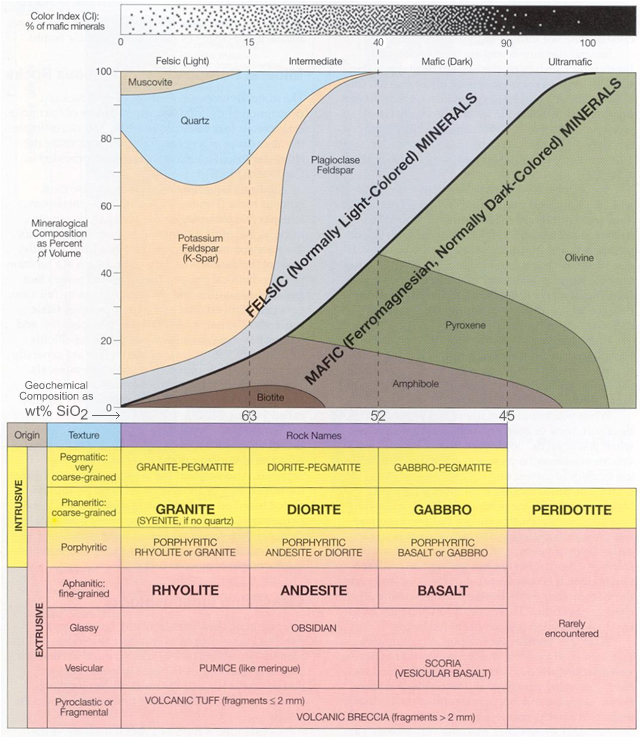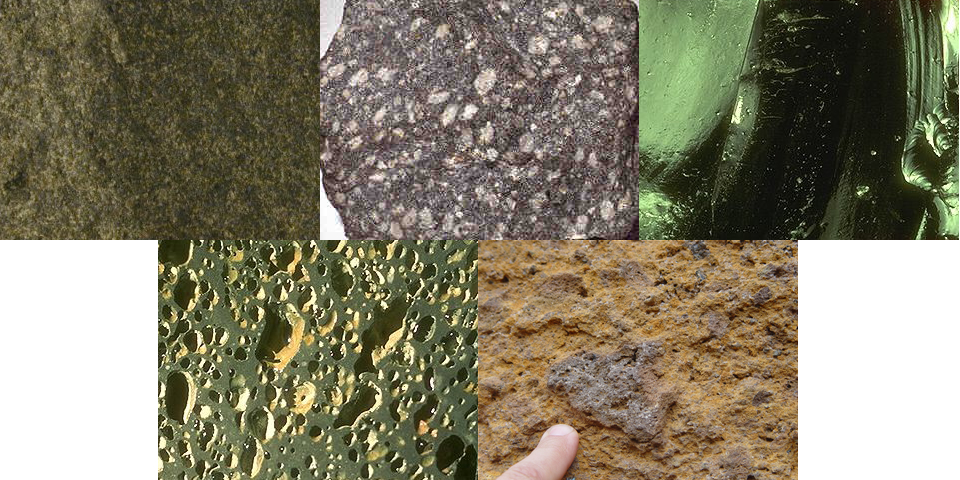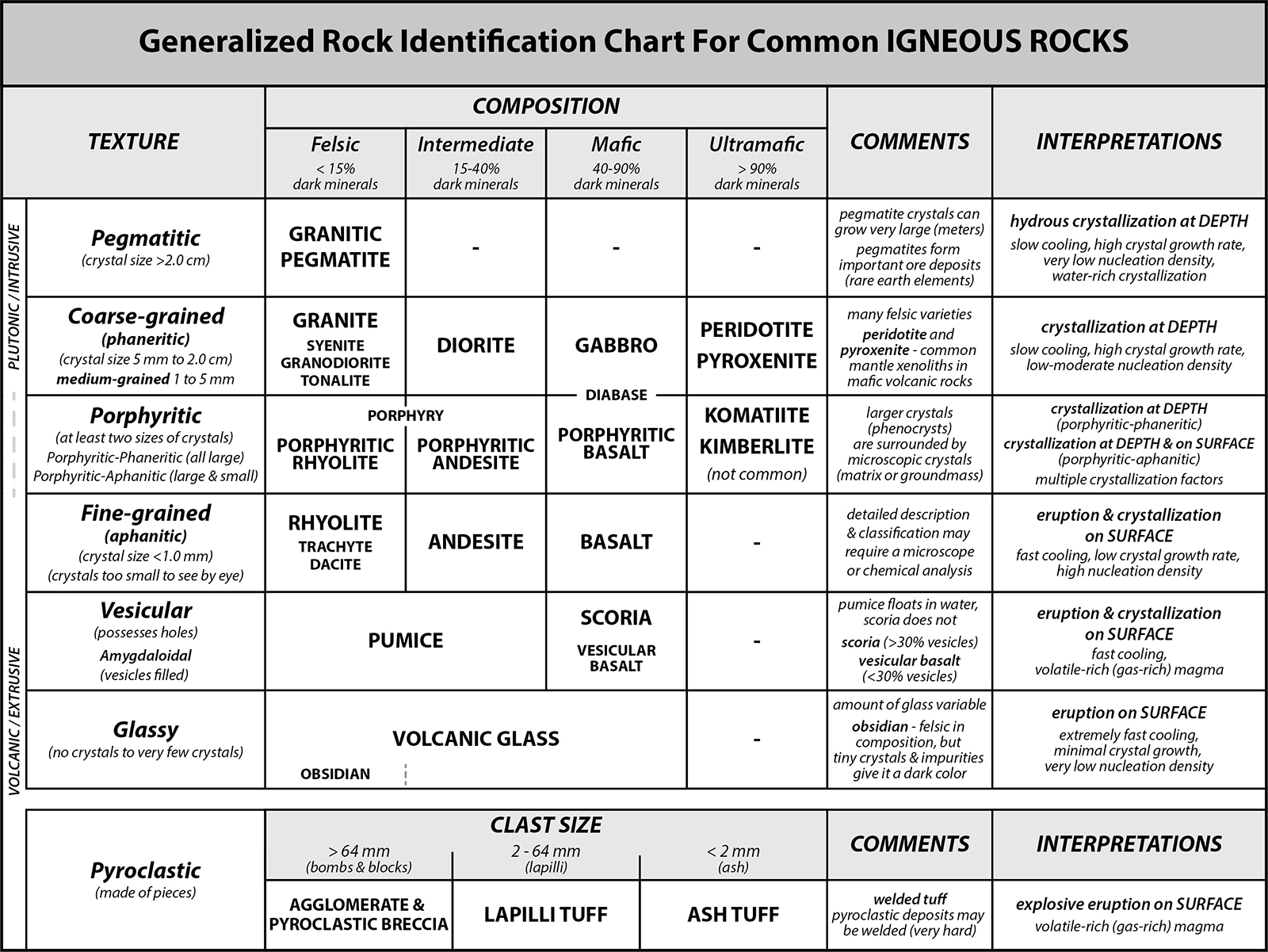Part A
Identifying & Interpreting Volcanic Rocks in the Field
Good news! The compositions of volcanic rocks are the same as for plutonic rocks, so you can apply what you learned about plutonic rock compositions to volcanic rocks. However, unlike plutonic rocks, volcanic rocks have several different types of textures. This is because of the varied styles of eruption and crystallization for volcanic rocks. The reason why this isn't bad news is that volcanic textures are really cool and relatively easy to recognize, which will make identifying them easier, too! The diagram in Figure 6-2 is a robust igneous rock classification chart that shows the composition, color index, mineralogy, weight % SiO2, textures and rock names.
|
Figure 6-2. A typical igneous rock classification chart, with added petrographic and geochemical information. |
Composition
As with plutonic rocks, the composition of volcanic rocks is a function of the minerals present in them. Since the individual mineral crystals in volcanic rocks are commonly too small to identify, geologists infer/describe the composition (and thus, composition) in several quantitative and qualitative ways that include field description, petrographic study, and geochemical analysis.
Field Description
Describing the composition classification typically involves a qualitative visual interpretation of the rock's composition based on its observable minerals and overall color :
> If the rock is generally light in color, then it is likely composed of light-colored minerals (like quartz and feldspar) and is felsic in composition.
> If the rock is generally dark in color, then it is likely composed of dark-colored minerals (like olivine, pyroxene, with lesser amounts of amphibole and plagioclase feldspar) and is mafic in composition.
> If the rock is generally gray in color, then it is likely composed of both light- and dark-colored minerals and can be described as having an intermediate composition.
IMPORTANT - Color is not always representative of rock composition! For example, obsidian is usually dark colored, but it is chemically similar to the light-colored rocks (a small amount of iron and/or lack of microscopic bubbles help to give obsidian its dark color).
Compositional Types
Both plutonic and volcanic rocks share the same compositional types: felsic, intermediate, and mafic. Volcanic rocks with ultramafic compositions exist, but are very rare and have not erupted on Earth in over 2 billion years. Be sure to pass your cursor over the rock pick icons to see rock sample imagery.
|
|
|
Figure 6-3. Volcanic rocks with different compositions. |
> Generally light-colored; <15% dark-colored minerals.
> Mineralogy - Light-colored minerals include quartz (gray to clear), alkali feldspar (peach-colored to pale red), and plagioclase feldspar (white to gray), whereas the dark-colored minerals are mostly biotite (black flakes).
> Geochemistry - High SiO2 (>63 wt%), Al2O3, Na2O, K2O, etc.; low MgO, FeO, and CaO.
> Typically forms from melting continental crust.
> Forms high viscosity lava ("thick & sticky").
> Crystallizes at low temperatures (650-700ºC).
> Volcanic rock examples: rhyolite, dacite.
> Typically gray in color if fine-grained or light and dark ("salt and pepper") if coarse-grained; 15-40% dark-colored minerals.
> Mineralogy - Light-colored minerals include plagioclase feldspar with lesser quartz, whereas the dark-colored minerals are mostly hornblende (black masses or needles) and biotite (black flakes).
> Geochemistry - Moderate SiO2 (52-63 wt%).
> Commonly forms from hydrous (water-rich) crustal melting, magma mixing, etc.
> Typically involved in explosive, pyroclastic eruptions.
> Volcanic rock examples - andesite, basaltic andesite.
> Generally dark in color; 40-90% dark-colored minerals.
> Mineralogy - Dark-colored minerals mostly include pyroxene (dark green to black) and olivine (green), whereas the light-colored minerals are mostly plagioclase feldspar (white to gray).
> Geochemistry - Low SiO2 (45-52 wt%), Al2O3, Na2O, K2O, etc., and high MgO, FeO, and CaO.
> Typically forms from melting ultramafic mantle.
> Forms low viscosity lava (thin & fluid).
> Crystallizes at relatively high temperatures (1000-1200ºC).
> Typically involved in passive, lava-rich eruptions.
> Volcanic rock examples - basalt.
> Very dark in color (black to green); >90% dark-colored minerals.
> Mineralogy - Dark-colored minerals almost exclusively pyroxene (dark green to black) and olivine (green).
> Geochemistry - Very low SiO2 (<45 wt%) and very high MgO, FeO, and CaO.
> Volcanic rock examples - komatiite.
![]()
![]()
Texture
Texture refers to the size, shape, and orientation of the crystals, or some other visible feature in the rock, and reflects its extrusive or intrusive origin. Unlike plutonic rocks, which generally have coarse-grained textures, volcanic rocks have several different types of textures.In general, the cooling rate and/or depth of crystallization and eruption characteristics can be inferred from volcanic textures, like those in Figure 6-4.
|
|
|
Figure 6-4. Volcanic rocks with different textures (clockwise from upper left): fine-grained, porphyritic, glassy, pyroclastic, and vesicular. |
> Mostly crystals <1 mm in diameter (hard to see without magnification). Larger crystals (phenocrysts) may be present, but are minor in abundance.
> Form as lava cools and crystallizes rapidly on the Earth's surface.
> Volcanic rock examples - basalt, basaltic andesite, andesite, dacite, rhyolite.
> An inequigranular texture with a mixture of larger crystals (phenocrysts) surrounded by smaller crystals (groundmass).
> Includes a mixture of phenocrysts surrounded by much smaller groundmass crystals. The abundance of phenocrysts can vary, but is typically <25% of the rock. Groundmass crystals are typically <1 mm in diameter and hard to see without magnification (aphanitic).
> Forms as magma crystallizes with at least two rates of cooling: one slower and at depth (forming the phenocrysts), the other faster and on/near the surface (forming the groundmass).
> The word porphyritic can be used as a modifier in the rock name (for example, basalt with olivine phenocrysts is termed porphyritic basalt or olivine basalt).
> A porphyritic rock with abundant, large phenocrysts may be referred to as porphyry (e.g., feldspar porphyry).
> Volcanic rock examples - porphyritic basalt, porphyritic andesite, porphyritic rhyolite, rhyolite porphyry.
> A significant (>5%) amount of void spaces (vesicles), which may be open or filled with secondary minerals.
> Vesicles form as a gas-rich magma erupts and cools so quickly that the lava solidifies around the gas bubbles.
> Volcanic rock examples - scoria, pumice.
> Crystals are few or absent.
> Some surfaces display conchoidal fracture that resemble concentric ripples.
> Forms as magma cools extremely fast, so there is no time for crystals to form.
> Volcanic glass alters (changes color, cracks, etc.) over time.
> Volcanic rock examples - volcanic glass, obsidian.
> Composed of fragments of various types (glass, crystals, or rock) and sizes ranging from very small (ash) to large (cinder, bombs,and blocks and bombs (>64 mm in diameter).
> Form during explosive volcanic eruptions.
> Volcanic rock examples - ash tuff, lapilli tuff, pyroclastic breccia, agglomerate.
![]()
![]()
![]()
![]()
![]()
Common Volcanic Rocks
There are many varieties of volcanic rocks. Slight variations in the composition or texture necessitate additional rock terminology. A few important volcanic rock types are briefly described below.
> Fine-grained to porphyritic, light-colored rocks that are felsic in composition.
> Mineralogy - Typically contain quartz, alkali feldspar, and plagioclase feldspar, with minor amounts of biotite.
> Dacite is compositionally between andesite and rhyolite, and has more quartz than andesite and more plagioclase feldspar than rhyolite.
> Geochemistry - >63 wt% SiO2.
> Originates from the melting of continental crust.
> Highly viscous lavas form short, thick flows and steep-sided lava domes. May include explosive eruptions.
> Rhyolite is the extrusive equivalent of granite, whereas dacite is the extrusive equivalent of granodiorite.
> Arizona examples - Superstition Mountains (near Phoenix); Chiricahua Mountains (southeastern Arizona), Kofa Mountains (southwestern Arizona); San Francisco volcanic field (near Flagstaff).
> A fine-grained to porphyritic, light- to gray-colored rock that is intermediate in composition.
> Mineralogy - Typically contains plagioclase and amphibole phenocrysts.
> Geochemistry - 52-63 wt% SiO2.
> Basaltic andesite is compositionally between basalt and andesite and has higher SiO2 (52-57 wt%) than basalt.
> Forms from hydrous melting of oceanic and/or continental crust, magma mixing, etc.
> Fairly viscous lavas that can be water-rich, helping to produce explosive eruptions of ash and lava that form steep-sided stratovolcanoes (composite volcanoes).
> Extrusive equivalent of diorite.
> Arizona examples - Tempe Butte (on the ASU campus); San Francisco Mountain (north of Flagstaff).
> A dark-colored rock that is mafic in composition.
> Mineralogy - Commonly contains olivine, pyroxene, and plagioclase feldspar.
> Geochemistry - 45-52 wt% SiO2.
> Basalt having 5-30% vesicles is called vesicular basalt, whereas basalt with >30% vesicles is termed scoria.
> Originates from the partial melting of ultramafic mantle rocks.
> Highly fluid lavas that erupt in a passive manner, forming lava flows, shield volcanoes, and cinder cones.
> Extrusive equivalent of gabbro.
> Arizona examples - San Francisco volcanic field (northern Arizona), Uinkaret volcanic field (NW Arizona); Perry Mesa (along I-17 in central Arizona), Sentinel volcanic field (along I-8 in SW Arizona).
> Dark-colored (either black or reddish brown) volcanic glass.
> Forms when lava is quenched (very suddenly cooled) and there is no time for crystals to form.
> Volcanic glass can have any composition. Obsidian is felsic, with a small amount of iron giving it a dark color.
> Typically dark in color due to various elemental impurities and lack of microvesicles, but alters (changes color, cracks, etc.) over time.
> Volcanic glass can occur in and around any explosive vent. Obsidian is typically associated with lava domes.
> Arizona examples: Locally exposed in felsic volcanic fields; Picketpost Mountain (Superstition Mountains).
> A dark-colored (reddish to black), fine-grained to glassy rock with a vesicular texture (>30% vesicles).
> Forms from gas-rich mafic lava. As magma rises to the surface, gas bubbles grow and try to escape as the magma/lava solidifies.
> Commonly found in cinder cones and shield volcano vent areas.
> Unlike pumice, scoria will typically sink in water because of its higher density.
> Arizona examples - Scoria is common in mafic volcanic fields where cinder cones are abundant (San Francisco volcanic field).
> A light-colored, frothy, volcanic glass that is extremely vesicular.
> Forms from gas-rich felsic to intermediate lava. As magma rises to the surface, gas bubbles grow and try to escape as the magma/lava solidifies.
> Typically erupted from stratovolcanoes, lava domes, and calderas.
> Pumice can actually float in water due to its low average density (from all the air pockets within it).
> Arizona examples - Pumice deposits are also locally exposed in the northern San Francisco volcanic field.
Pyroclastic Rocks (Agglomerate, Pyroclastic Breccia, Lapilli Tuff, Ash Tuff) ![]()
> Pyroclastic rocks are made of pieces where the size of the pieces can vary from ash-sized (very small) to large blocks and bombs (meters in diameter).
> Tuff is a word generally used to describe fine-grained airfall material (tephra).
> Ash tuff is a fine-grained pyroclastic rock where the average size of pyroclastic particles is ash-sized (<2 mm). Ash tuff may be massive or well-bedded, and can be transformed by high-temperatures after deposition into more resistant welded tuff.
> Lapilli tuff is a pyroclastic rock where the average size of pyroclastic particles is gravel-sized (2 mm to 64 mm).
> Pyroclastic breccia is a coarse-grained pyroclastic rock where large angular clasts are boulder-sized or bigger (>64 mm).
> Agglomerate is formed from molten to partially molten airfall material (spatter, volcanic bombs) that typically welds together along the rims of volcanic vents.
> Pieces can include solidified lava, as well as rock fragments accidentally caught in the eruption.
> Pyroclastic rocks are formed in a wide range of volcanic eruptions most commonly related to cinder cones, stratovolcanoes, lava domes, and calderas. The smaller the fragments, the more violent the eruption.
> Arizona examples - Peach Springs Tuff (northern Arizona); felsic volcanic fields (Superstition, Chiricahua, etc.).
Field Identification
The field classification for volcanic rocks is similar to what we did in the previous lab with plutonic rocks: identify the texture and composition. Volcanic textures are fairly distinctive and general color or mineral phenocrysts are used to estimate composition. Knowledge of both the texture and composition yield the name of the volcanic rock, and may also allow us to make some general interpretations abouhow and where the rock formed. The textures and compositions of the main volcanic rock types are included in the Igneous Rock Identification Chart below.
|
Figure 6-5. A rock identification chart for common igneous rocks (including volcanic rocks. Click HERE for a printable PDF version. |
* IMPORTANT *
Using the PDF link above, print a hard-copy version of this chart for use in this lab and the lab quiz.
Examine the texture and composition of each sample to answer Quiz Me! questions A08 through A20. Refer to the igneous rock classification chart (Figure 6-6) and the rock descriptions.
![]()
![]()
![]()
![]()
![]()
![]()
![]()
![]()
![]()
![]()
![]()
![]()
![]()



